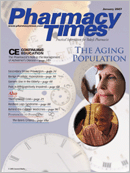Publication
Article
Pharmacy Times
generic times: product profiles
Author(s):
Doxycycline
Microbial resistance is always a concernwhen determining proper antibiotictherapy. The tetracycline class presents atherapeutic alternative for many infections,especially some rarely encounteredvarieties of advanced diseasesinvolving the skin.
Doxycycline is a semi-synthetic derivativeof the antibiotic oxytetracycline andis indicated as adjunctive treatment for abroad spectrum of susceptible infections,including those of the respiratoryand urinary tracts and skin, and forsevere acne. Doxycycline is available in50-, 75-, and 100-mg tablet strengthsfrom Ranbaxy Pharmaceuticals.
Pharmacology
Doxycycline is bacteriostatic, inhibitingthe binding of transfer-RNA at theribosomal level of the microbe. Theeffect is selective for infecting bacteria,since the doxycycline molecule can onlyreach the cell ribosome by an activetransport mechanism that does not existin human cells.
First-line therapy using doxycycline followsthat of the tetracycline class andincludes treatment for rickettsial disease,Chlamydia trachomatis, brucellosis,cholera, Mycoplasma pneumoniae, Lymedisease, anthrax, and gastric infectionsinvolving Helicobacter pylori. In addition,oral doxycycline is indicated duringGrade III acne vulgaris.
General Dosage and SpecificIndications
The usual adult dose for doxycycline is100 mg every 12 hours for the first day,then 100 mg daily given in 1 dose or 2divided doses. For severe infections,patients may require 100 mg every 12hours. Children less than 45 kg are dosedby weight, with the first day's dose being4.4 mg/kg and followed by daily doses of2.2 to 4.4 mg/kg, depending on theseverity of the infection.
Specific infections involve specializeddosing regimens. For rickettsial infections(such as Rocky Mountain Spotted Fever),dosing is continued for at least 3 to 7 daysor until the patient is afebrile for 2 to 3days. Chlamydial infectionsshould be treated for up to14 days to prevent arelapse. Uncomplicatedgonorrhea is treated with100 mg twice a day for aweek, or, as an alternative,with an initial 300-mg dose,followed by a second 300-mg dose 1 hour later.Brucellosis is treated with200 mg of doxycycline dailyfor 4 days, followed by a100-mg daily dose for thenext week. For the treatmentof cholera, some clinicianssuggest a single300-mg dose. For postexposureprophylaxis toanthrax, the 100-mg twice-daily dose iscontinued until exposure confirmation,and then continued for 60 days if anthraxhas been confirmed. Oral doxycyclineeven has a role in postexposure prophylaxisfor plague and malaria.
For acne vulgaris, treatment withdoxycycline can last for 6 to 8 weeks,with a tapering of the dose at the end oftherapy. Total duration of treatment foracne vulgaris with doxycycline shouldnot exceed 4 months.
Side Effects and Interactions
Tetracyclines as a class are associatedwith tooth discoloration when usedin patients younger than the age of 8,and photosensitivity reactions can onlyenhance the discoloration once permanentteeth emerge. Chelation with calcium,iron, aluminum, magnesium, zinc,and lithium are also possible, requiringnonconcurrent dosing. The potential forrenal Falconi's syndrome remains possiblefrom ingesting outdated doxycycline,but this reaction is consideredvery rare.
Unlike other tetracycline antibiotics,doxycycline may be used by patientswith renal impairment without an adjustmentin dosage.
If necessary, the tablets of doxycyclinecan be crushed and mixed with food orliquid to mask the taste. Chocolate flavoring,whether in milk or pudding, providesthe best coverage, while grape,strawberry, and cherry inadequatelycover the bitterness of the crushedtablets. To minimize esophageal irritation,any such formulation should be followedby adequate fluids and should notbe administered too close to bedtime.
Clinical Outlook
Doxycycline remains a versatile optionfor the treatment of a variety of infections.This version is comparable with thebrand name product Adoxa (BradleyPharmaceuticals Inc).
Zonisamide
The treatment for seizure disorders islikened more to an art than a science.With nearly 5 in 1000 afflicted, and with aresistance rate of up to 30%, it oftentakes a creative mixture of drugs to provideeffective seizure control.
Zonisamide is an import from Japan,where it had been used for nearly adecade before its introduction in theUnited States in 1998. It is available in 25-,50-, and 100-mg capsules fromMylan Laboratories Inc.
Pharmacology
Zonisamide is a sulfonamide.Its specific mechanismof action, as for many drugsthat affect the central nervoussystem, remains unknown. Controlof seizures is postulated to involve slowingthe flow of sodium and calcium at theneural membranes. In addition, it maypotentiate the effects of dopamine andserotonin but has not shown an effect onthe synaptic effects of gamma-aminobutyricacid.
It is currently indicated as combinationtherapy for managing partial seizures. Likemany therapies for seizures, it is alsobeing used as an adjunct in the treatmentof intractable neuropathic pain.
Dosing and Administration
Initial adult dosing of zonisamide is 100mg daily for the first 2 weeks, with 100-mg increases at 2-week intervals.Therapeutic effectiveness is usuallyreached at daily doses in the range of100 to 600 mg, with 400 mg being theusual daily maximum. This titration maytake longer among patients with hepaticimpairment. Discontinuing therapy withzonisamide should be done throughgradual tapering to prevent a rebound inseizures.
Side Effects and Interactions
An allergy to sulfonamides is a specificcontraindication to the use of zonisamide;and, like many drugs used totreat seizures, zonisamide is associatedwith fatigue, impaired concentration, andpsychiatric symptoms.
Zonisamide should be stopped immediatelyif symptoms of allergy occur, asdeaths have been reported due toStevens-Johnson syndrome and toxicepidermal necrolysis. In fact, stoppingzonisamide should be considered withthe emergence of any unexplained rash.
About 4% of patients have experiencedkidney stones, with other renaleffects being a substantial increase inserum creatinine and blood urea nitrogen.Zonisamide should be avoidedwhen renal failure is present.
Decreases in the ability to sweat alongwith hyperthermia have been reported inchildren younger than 17. Some of thesecases have required hospitalization forheat stroke. Children requiring zonisamidein addition to their establisheddrug regimen require careful monitoring.Although zonisamide does notaffect the clearance of phenytoinor carbamazepine, concurrentuse of these drugs increases theclearance of zonisamide.
Clinical Outlook
Seizure disorders continue torepresent a great challenge for clinicalcontrol, with the traditional treatmentsinvolving phenytoin, phenobarbital, andvalproic acid being frequently inadequate.Zonisamide represents an additionallayer of therapy which, if properlymonitored, can afford up to 50%additional relief from the symptoms ofpartial seizures. Although the drug iseffective for some neuropathic painrelief, the strongest effects seen in thatcategory are among cases involvingphantom pain or a condition known asreflex sympathetic dystrophy. Diabeticneuralgia appears to be less responsivein the few controlled studies conductedthus far.
Mr. Middleton is an instructor of pharmacologyat Kellogg CommunityCollege in Battle Creek, Mich.







